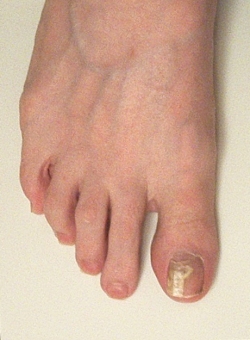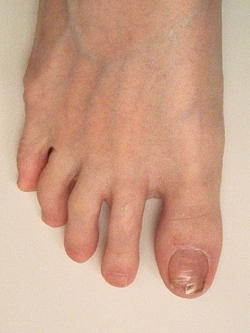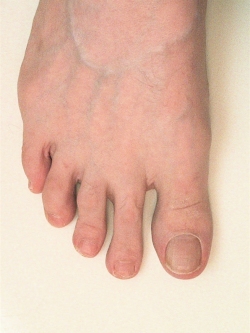|
In 2004, Michael developed a severe fungal toenail infection in his right
big toe after the toenail became damaged in a household accident.
A trip to Michael's doctor confirmed that the nail and nailbed were
severely infected with a fungus. After Michael discussed treatment options with his MD, we reviewed
our options.
Both of us were reluctant to consider oral prescription antifungals, the standard
treatment that was recommended, due to the high cost and relatively low cure rate for that protocol.
We therefore turned to the web to research other options.
Although the web is rife with claims of cures from home remedies, we
didn't find any convincing data to bear out these claims.
We therefore decided to carry out our own case study, using hydrogen
peroxide and vinegar, to see if these two inexpensive, widely available and relatively safe substances
could cure a toenail fungus infection. We consulted Michael's MD to make sure he had no concerns
about our plan. He agreed that it had little or no possiblity of harm and was in fact quite
interested in seeing the results.
We decided to use 5% vinegar and 2% hydrogen peroxide soaks
(about 5 minutes of soaking time) on alternate days for 3 weeks. Starting in April of 2004, Michael
soaked the toe in vinegar for five minutes on one day, then soaked it in hydrogen peroxide the
next day. 3% hydrogen peroxide was diluted to 2% by adding distilled water, so as to make the
hydrogen peroxide solution slightly less caustic on his exposed skin. We never mixed hydrogen
peroxide and vinegar together, as under the right conditions that forms peracetic acid, a caustic
chemical with entirely different properties.
Each day, Michael used a press-and-release technique on the
toenail to get the vinegar or hydrogen peroxide under the toenail to the infection site at the base
of the nail.
|

|
Illustration One (left) shows Michael's toe as of June of 2004.
After three
weeks of treatment, new healthy nail growth has started along the entire base of the toenail.
|
|
|
Illustration Two (right) shows Michael's toe as of January 2005.
Healthy nail
continues to grow up from the base of the nail. No evidence of any new fungal growth is
present, even though the three-week-long treatment with hydrogen peroxide and vinegar soaks
stopped six months earlier, and no additional treatments have been used.
|

|
|
|

|
Illustration Three (left) shows Michael's toe in September of 2005.
The entire toenail and nail bed are healthy and free of any signs of fungal infection.
|
|
The toenail remains free of fungal infection as of August 2008. We
used this same protocol when Judy developed a toenail fungus infection in 2007, with
equally good results.
If you are interested in trying this protocol, please consult your
physician first. This article should not be construed as medical advice. You can
click here for a PDF copy of this article that you can print and take to your doctor.
|
MiniFAQ: The questions we get asked the most about this article, with
answers.
- What is the "press and release" technique?
Answer: Press on the toenail, then release it, and repeat that several times while
you're soaking the affected toenail. The idea is to get the liquid into every nook and cranny
that it can get into.
- Can I use apple cider vinegar (or rice vinegar or some other type of vinegar than white
distilled vinegar)?
Answer: As far as we can tell, using apple cider vinegar or rice vinegar or any other similar
edible vinegar works the same as the white distilled vinegar -- no better and no worse. We've
had many people contact us saying that they used apple cider vinegar in place of the white
distilled vinegar and had equally good results.
- Can I save the vinegar/hydrogen peroxide and reuse them or do I have to use fresh every time?
Answer: Always use fresh. Never reuse the vinegar or hydrogen peroxide.
- Is there any way to use less vinegar or hydogen peroxide?
Answer: Put your foot in a plastic shoe box or any plastic box your foot fits into, and then dribble the
liquid right over just the infected toes, using an eyedropper. Thoroughly soak each infected toenail,
press on the nail to get the liquid to flow into the edges, and release the nail. Repeat (soak each
toenail with more liquid, then press and release) every minute or two until you're done for that session.
- Do I have to dilute the vinegar?
Answer: In the United States, the vinegar you buy at a grocery store for use in
cooking or in salad dressings is already diluted and ready to use in the way this article
describes. The bottle will say on the label somewhere "5% acidity." In other countries, check
the vinegar bottle's label and make sure that the vinegar you are buying is already diluted so
that it is only 5% acidity.
- How do I dilute the hydrogen peroxide from 3% (as it comes from the store) to 2%?
Answer: Add 8 fluid ounces (1 cup) of hydrogen peroxide to 4 fluid ounces (1/2 cup) of
distilled water. If you want to dilute a different volume of hydrogen peroxide, you can figure
it out using a
dilution calculator.
- Why can't I just pour the hydrogen peroxide and vinegar together and use that?
Answer: The idea is to alternate between using hydrogen peroxide one day, and then vinegar
the next. Also, you don't want to ever pour vinegar and hydrogen peroxide together in an
open container, and you absolutely never ever mix them in a closed container. Under exactly
the right conditions mixing them together can create peracetic acid. It's more likely to
happen in a closed container, but under the right conditions it might occur when pouring them
together in an open container.
- Why do you make such a big deal about avoiding peracetic acid?
Answer: Peracetic acid can be highly corrosive, and it is a "primary" irritant. It can
permanently damage the lungs, and cause occupational asthma. It can also have other chemical
properties depending on the concentration that make it quite dangerous in other ways as well.
- How long did Michael have the toenail fungus before trying this?
Answer: Michael had the fungus for several months before treating it with this technique.
People who had fungal nail infections for over 20 years have written to let us know that
this technique cured it when nothing else ever had.
- Why did Michael only treat his nail for three weeks?
Answer: Michael quit using the treatment after 3 weeks because all of the nail growth coming
out of the nail bed was normal. The idea is to treat until you see good solid clean healthy
nail as all that's growing out of the nail bed. Some people who've contacted us have required
longer.
- Did you trim the affected nail?
Answer: Michael trimmed the affected nail so it was short (you can see that in the photos).
In Michael's case, the nail was riddled with holes through it as well, so the press and release
technique really helped to get the solution under the damaged areas of the nail.
|
|
Design, layout, graphics and contents copyright
1999-2021 Judy Stouffer. All Rights Reserved. The articles, graphics and images on this website
may not be copied or published anywhere, including in any electronic format, without specific
permission from Judy Stouffer, B.S., M.S.
|
The pages on this website have been viewed millions of times by visitors
from more than 140 countries since going online in March 1999.
Page last updated: March 21, 2021
|
|

